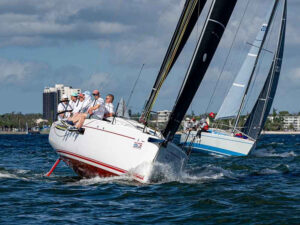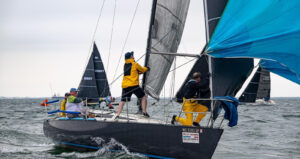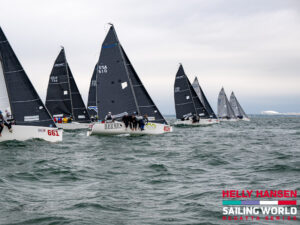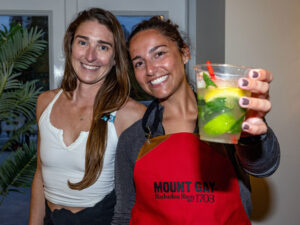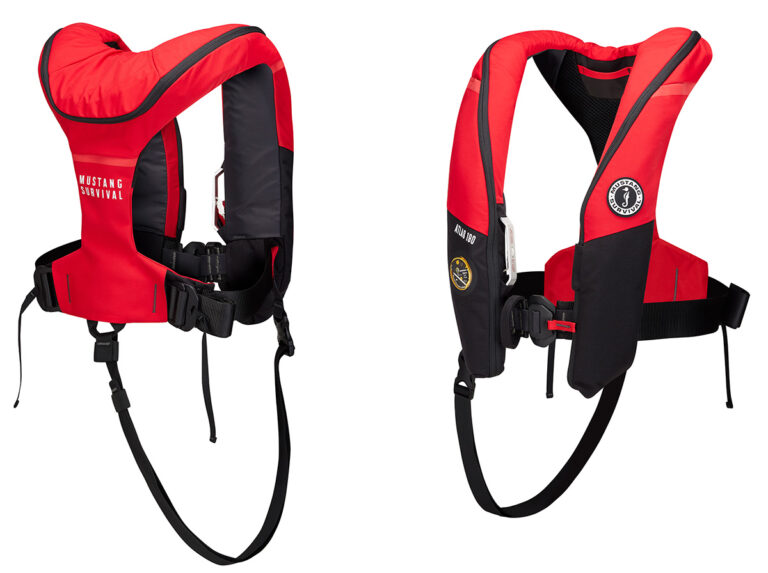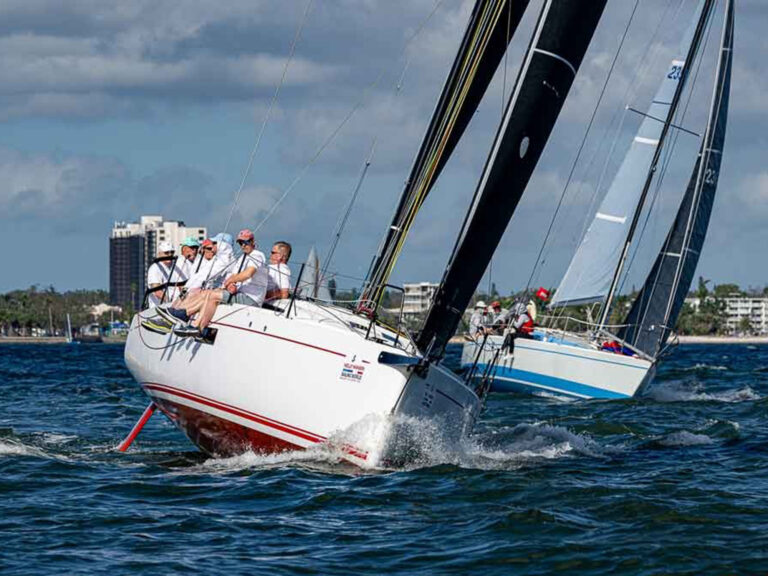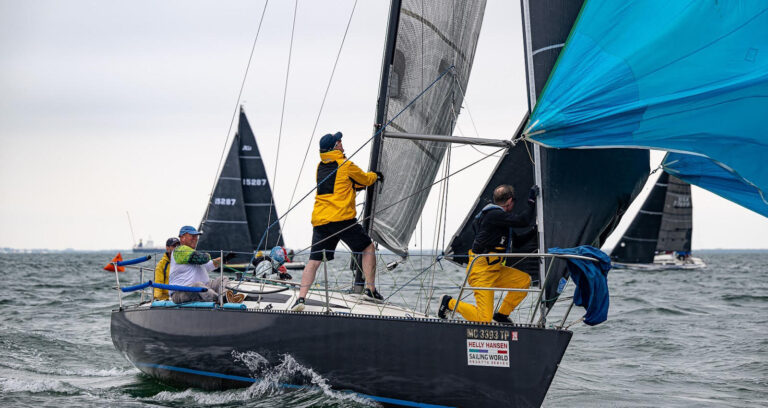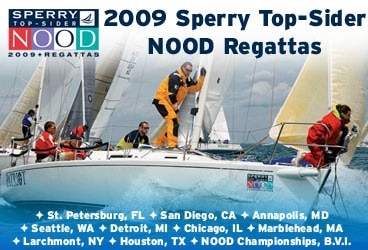
NOODBanner368
Regatta Info Center
Entry Form as a PDF to Mail or Fax in
List of Class Coordinators for Houston NOOD 2009
List of Entries
September 27, 2009
Experience Pays Off for Mr. Happy
Bob Harden’s been sailing the J/24 for more than 30 years. He’s learned quite a bit about the boat in those three decades. Of course one of the most important lessons is, never get too confident. With one race remaining in the 2009 Sperry Top-Sider Houston NOOD Regatta, Harden’s veteran team from Austin, Texas, on Mr. Happy was in second, one point behind Corey Harding’s Happy Dance, who also had the tie break. Boat names aside, one boat wasn’t going to be so pleased with the outcome of the final race.
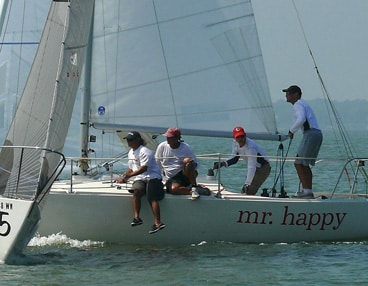
Stuart Streuli| |**Bob Harden’s Mr. Happy goes into a tack just before the windward mark during the 2009 Sperry Top-Sider Houston NOOD Regatta. Harden took overall honors in the event. **| Harden won the start, and then did his best to keep at least one boat in between him and Harding to ensure the class win. His come-from-behind victory also earned him overall regatta honors for the final NOOD regatta of the 2009 season, a prize that comes with a Suunto Elementum Ventus watch and a Sunsail charter boat for the 2009 NOOD Caribbean Rendezvous in the British Virgin Island in November. The finalists for the overall winner, who also received Suunto watches, were Yandell Rogers in the J/80 class, and Buddy Brown in the Ensign division.
Harden’s crew on Mr. Happy included: Mike LeFebvre, trim; Tom Lappin, compass, Eric Nelson, head cheerleader; Jay Sacco, bow.
SW: Bob, tell us about yourself?
BH: I’m from Austin, TX, I’m a groundwater consultant and a hedgefund manager
SW: Because one of those jobs isn’t enough for one person?
BH: Well, to be very honest, I was successful enough in one that I had to figure to what to with my money.
SW: So you were successful enough as a hedge fund manager and now you’re a groundwater consultant?
BH: Other way around. It’s interesting, sailing there’s a lot of risk-reward calculations and valuations. It’s a lot like investing. I just think that way.
How long have you been sailing J/24s?
I’ve been sailing J/24s since 1977. We had 791, Running on Empty, my father. So I’ve been sailing since the beginning.
Never had I desire to move to another class?
Well, I could. But I don’t just because the guys I sail with, I’ve sailed with for going on 15 years. Eric and I have sailed almost 800 sailboat races together and our crew, all five of us, have sailed probably 250 races together.
So speaking of risk reward, that can be key in a light air regatta where the fleet splits apart and the wind is patchy. How did you handle the light air conditions?
In light air we just try to sail as fast as we can. You can try to cover, but you can’t, the course is too big. You just have to sail what you have around you, the best you can. People will pass you, there’s nothing you can do about it. You just have to keep, plugging away in whatever’s just around you, in the moment of now, and not get too worried, too blown out of shape when someone starts beating you because they’ve got better wind. It’s just the way it happens. Just keep plugging away, keep working. You can see the scores are all up and down, that’s indicative or our fleet. We have some closely competitive sailors. Corey Harding, you should mention him, those guys sailed their best races they ever sailed this weekend. There’s a couple of races where they got the best start and they left us. We’ve won here in Texas for many, many years. Those guys sailed really well.
What are the biggest benefits of having such amazing continuity with your crew?
It allows us to have each have his own individual job on the boat, but also have a head in what’s going on around us. Jay’s calling the boats below us through the jib: “You’re lane’s coming up. Lane’s not going away. Now you’ve got a lane, now you don’t.” Tom’s got the handbearing compass: “You’re gaining bearing, you’re losing bearing, your layline is there.” It just allows each person to have a component of contribution. There’s so much going on out there that you can’t have enough contribution. That’s one thing I love about the J/24 fleet. People talk about, well there’s exctra crew, that’s just more opportunity for teamwork and contribution.
Going into the last race, you were down by a point. Take me through that last race.
We got off the line at the pin end of the line. The pin end was slightly favored. We just sailed fast. The boat that was a point ahead of us didn’t quite get as good start, Corey and them, they had to duck some transoms and stuff. As soon as we could take with clear air and clear the other boats, we did. We just kept pressing forward as fast as we could, watching, and covering, and trying to help lead the fleet around the way Corey was going because there was a lot of boats between us and we didn’t want him to get off by himself. So when he jibed downwind, we would jibe with him to try to pull the fleet toward him. We tried to keep everybody covering him.
Corey was making the right moves, so when he would make those right moves, we’d instantly covering, even though the boats we [were near], it might make sense to stay near them. We’d immediately move back toward the right move and the rest of the fleet would tend to respond and that helped cover him with boats and not let him get off by himself to get away.
What are some of your secrets to driving a J/24 in light air?
Well any boat, you’ve got to really reach. You can’t try to point too high. You’ve got to foot off, get your momentum going and keep it moving. Err on footing, don’t try to point too high. One little windshift and all of the sudden you’re pinching and you’re slowing down really quick. It’s maintaining your momentum through it all.
Downwind, same thing. Anytime you get a puff you want to push it downwind, but you’ve got to get pushing it back upwind to keep your momentum to get your VMG just right.
-Stuart Streuli
September 26, 2009
Another light day of racing on Galveston Bay. Unlike yesterday, the sun was out for most of the day. However, the wind was very similar, light and mushy. Two races were held for each of nine classes.
September 25, 2009
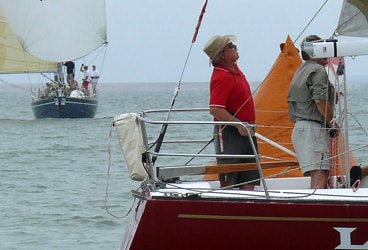
Stuart Streuli| |Tom Sutton’s J/35 Leading Edge rolls around the leeward mark in Race 1 of the 2009 Sperry Top-Sider Houston NOOD. Sutton leads the Level 70 class with a first and a second.| A Light Start to the Final NOOD of the 2009 Season
“It’s never like this here this time of year,” said one long-time Houston sailor this afternoon, after a frustrating day of sailing in a breeze that wasn’t much to begin with and got worse from there. Then he thought for a second. “Well, actually in September you can get great weather, and you can get this,” he motioned toward the greyscale sky. “The ocean’s still so warm from the summer, it can confuse the breeze.”
The outside course, which included the J/80s, J/105s, sportboats, and both the asymmetric and symmetric Level 70 class-why they’re not racing together is a bit of a mystery that supposedly involves a grudge or two-got in two races before Galveston Bay glassed over. The smaller boats, sailing just off the Houston Yacht Club, were not as lucky. The bulk of the J/24 fleet crossed the finish line for Race 1 in the last vestiges of the breeze, while the J/22s drifted across. The Catalina 22s were not so lucky. They couldn’t finish their race within the time limit. On the positive side, everyone in that class is still tied for first.
-Stuart Streuli
September 22
So the previews have been a little slow coming in from the class coordinators in Houston. But we do have one to feature
**Catalina 22 Spinnaker Class
**The Catalina 22 Texas State Spinnaker Championship is held each year at the Houston NOOD. Although most of the class sails non-spin, there are quite a few who appreciate how well this boat sails with a spinnaker. This year’s fleet includes two past class champions, Pete Harper and Gene Ferguson. There are Class Championships in both classes, spinnaker and jib-genoa, and these two skippers have each won in both. They’ll have competition, though, from the other skippers, and sailing in Galveston Bay can sometimes be challenging for this boat, especially in heavy air with big chop.
-Marilyn Boemer
August 24
Stuart Streuli will be providing on-site reports from the event, which begins on Sept. 25. Check back soon.

